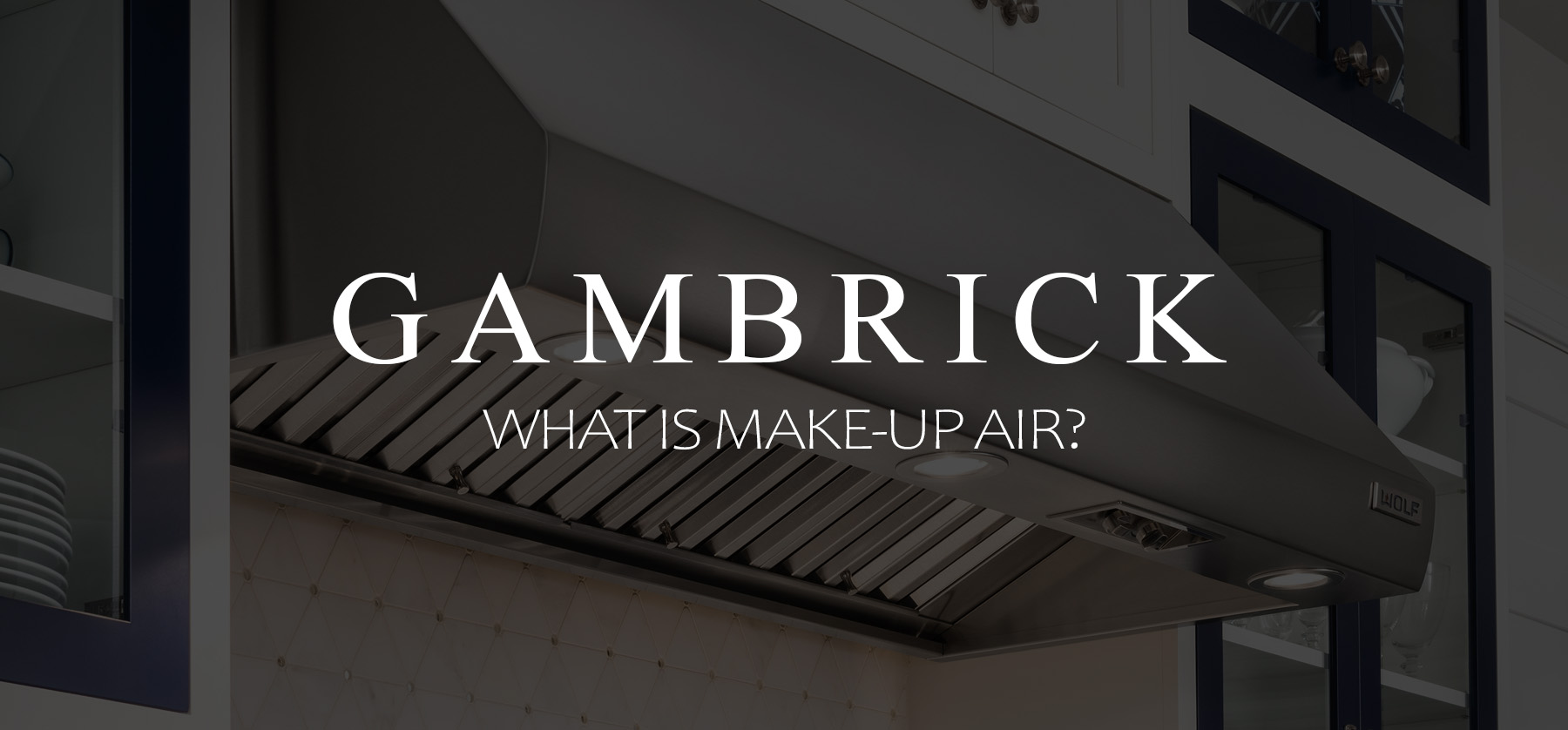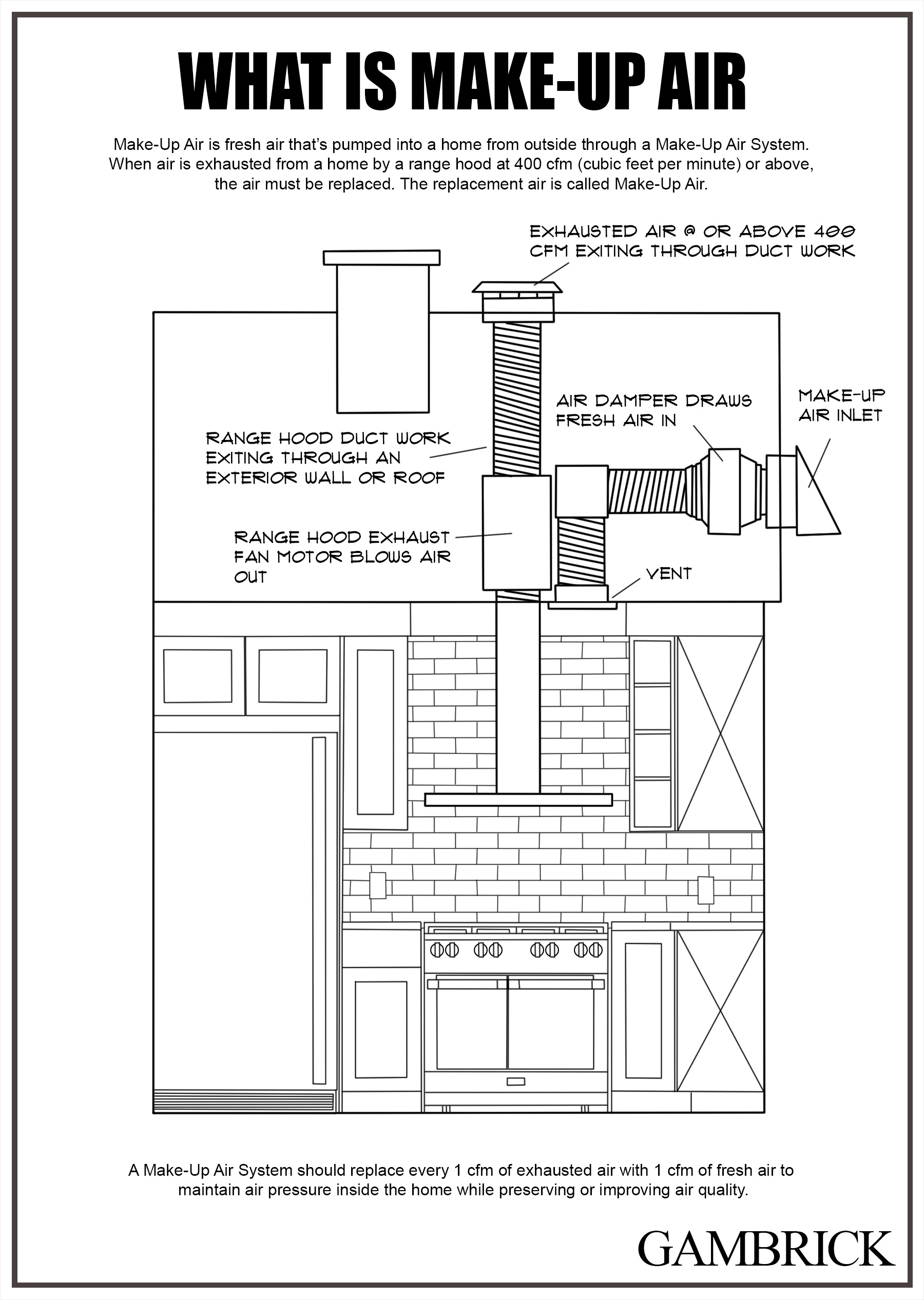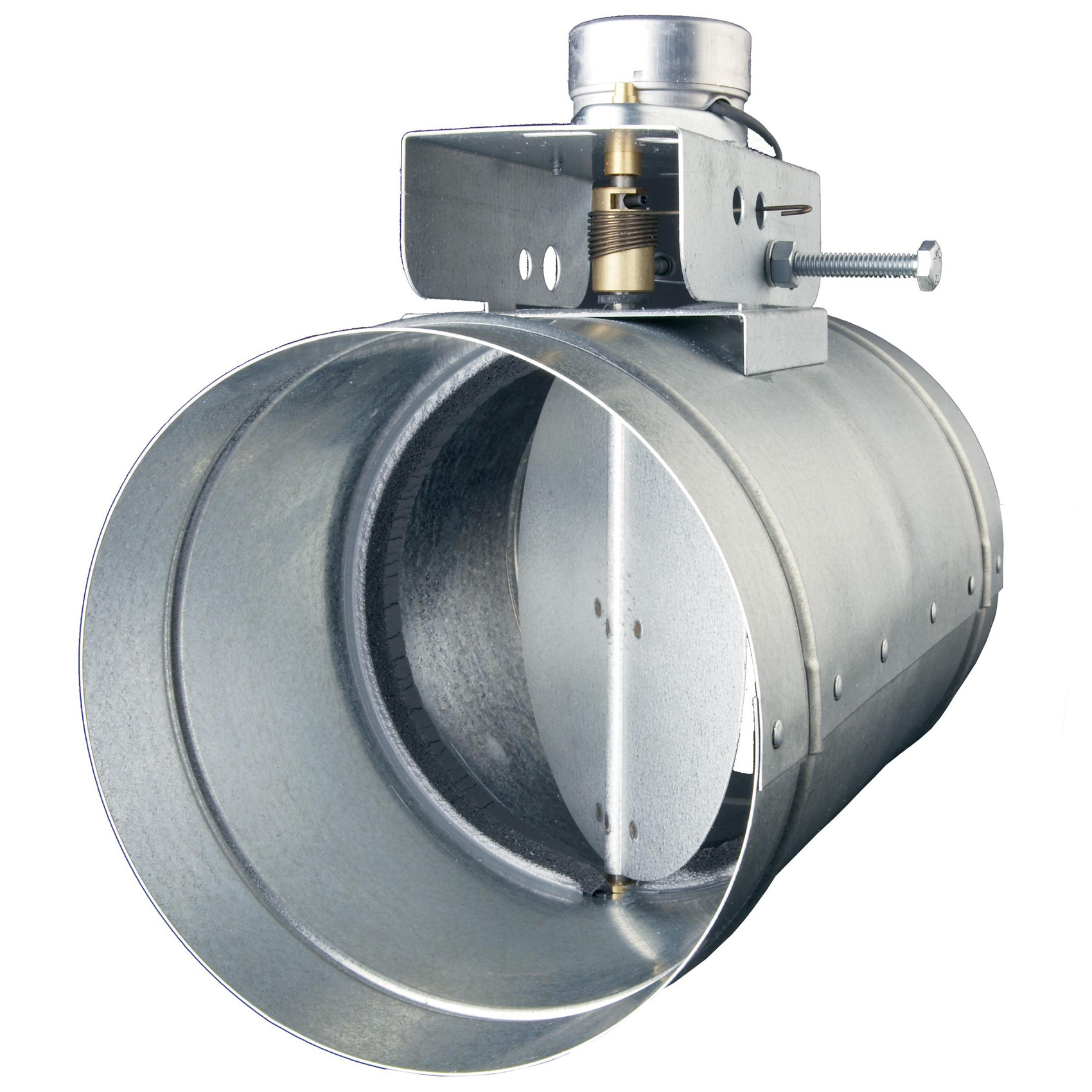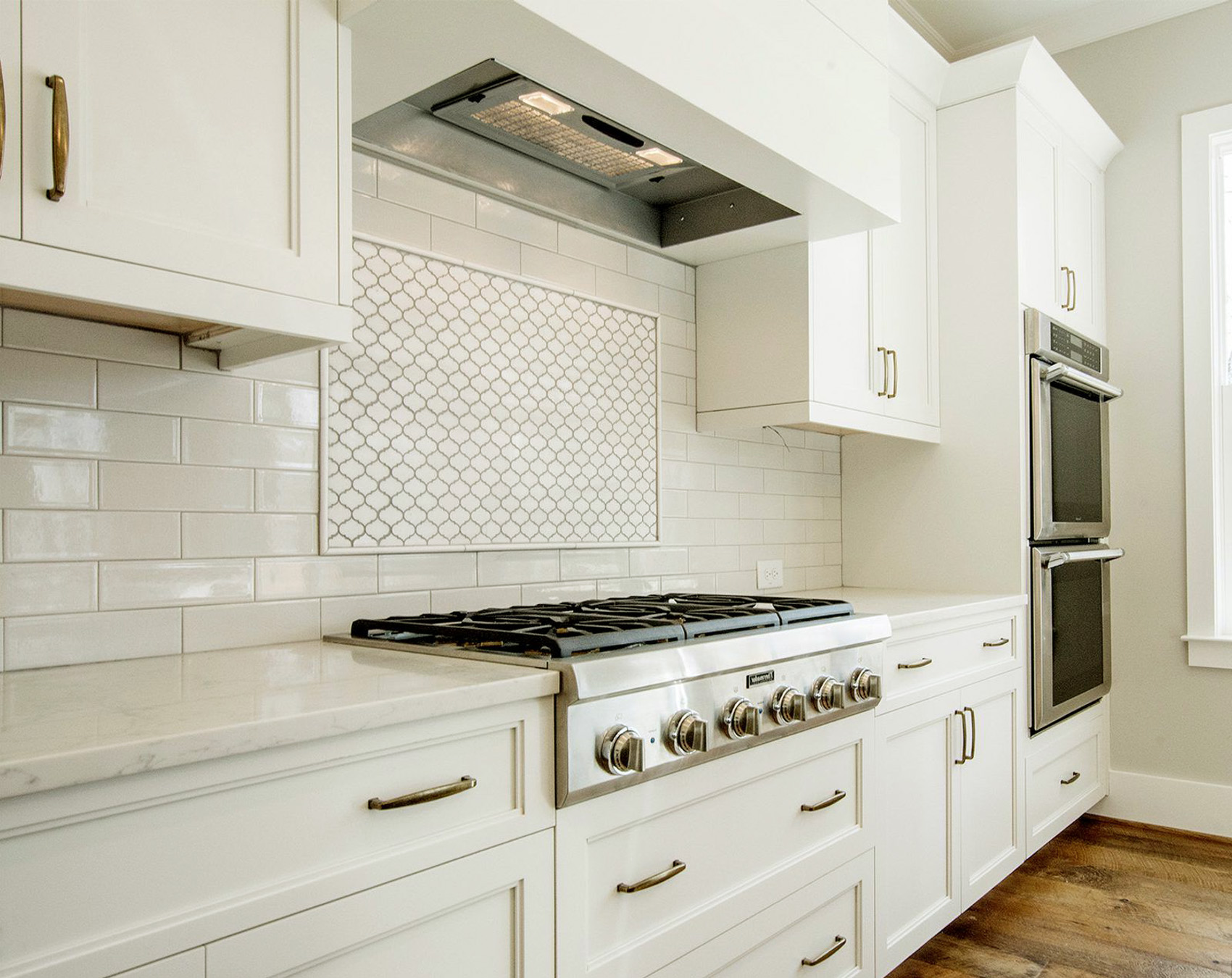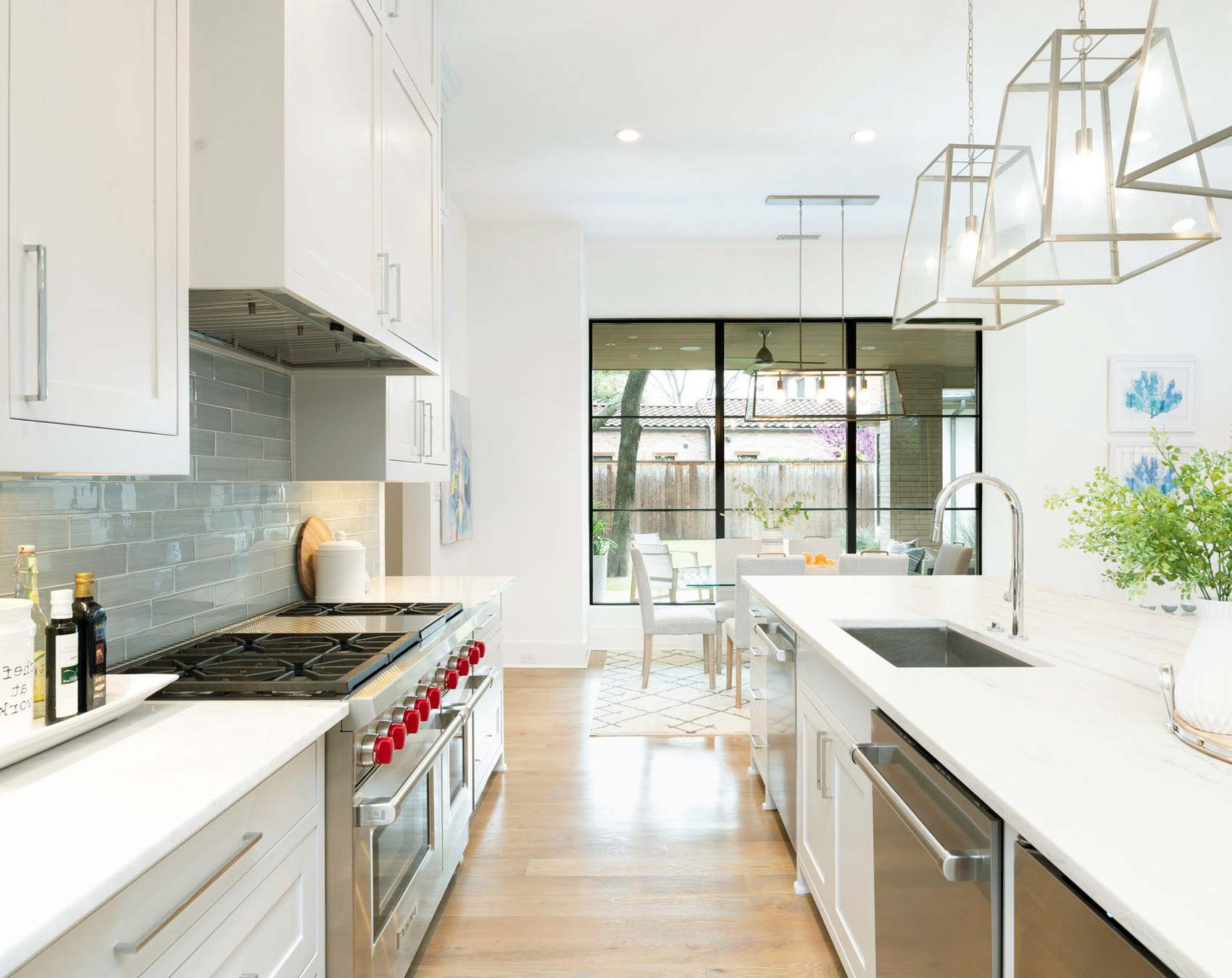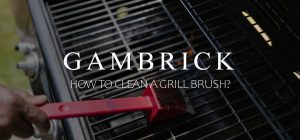What Is Make-Up Air
Make-up air is outside fresh air that’s pumped into a home to “make up” for air that’s been removed by exhaust fans like a range hood. This type of HVAC system pulls in fresh air from outside the home with a device called a damper, which connects to the exhaust fan. Beginning in 2009 and in every version since, the International Residential Code (IRC) has required that makeup air be provided for kitchen hood exhaust systems with capacity of 400 cfm (cubic feet per minute) or greater. Ideally, any air the hood blows out of the house above 400 cfm will be replaced by the damper. When the exhaust fan is turned on and blowing out 400 cfm or more, the damper automatically turns on and replaces the vented air with fresh outside air.
A makeup air damper is wired into the exhaust hood and works automatically. Once the hood is blowing out 400 cfm or more, the damper turns on and brings in fresh air. You don’t have to manually turn the damper on and off because it does that by itself.
The damper brings in fresh air through duct work and two vents. One vent must be on an exterior wall so that fresh outside air can be brought in. The second vent is located in the same room as the exhaust hood so that it can replace the vented air.
A range hood and makeup air damper are essentially two parts of an air circulation system. The hood blows out hot air while the damper sucks cool fresh air back into the house. When the system is working properly, vented air above 400 cfm will be replaced 1:1 with outside fresh air so no air inside the home is lost.
How Does Make-Up Air Work
A makeup air system is very simple. Any air above 400 cfm (cubic feet per minute) that’s pumped out of the house is replaced with new fresh air. This is done by a A make up air kit, also called a make up air unit or makeup air system. The system includes a range hood damper and an air pressure sensor that controls the flow of outside air into the home.
The damper is wired directly into your range hood controls. When the hood is venting air out of the house, the damper automatically turns on and starts bringing in fresh air to replace the vented air. This is done when the vented air meets or exceeds 400 cfm.
A makeup air system and range hood work together to form an air circulations system. Air that’s sucked out of the house by the hood is brought back in by the damper.
Without makeup air, the home would become depressurized. Air from the outside will rush in from anywhere it can to make up the difference in air pressure. This includes other duct work, vents, a fireplace or drafts.
When air rushes in to replace vented air, it can cause back-drafting. This can be harmful but can be avoided by installing a make-up air system. For example, when back-drafting happens at a fireplace vent, it can bring harmful Carbon Monoxide gas back into the house that should be venting out. A makeup air system helps prevent back-drafting by maintaining stable air pressure inside the home.
When you turn your range hood on and it pulls out air from your home, that air needs to be replaced. If this air is not replaced, you may experience depressurization, worsened indoor air quality, back-drafting, drafts and possibly shortness of breath or lightheadedness.
What Is Make-Up Air CFM?
CFM stands for cubic feet per minute. When discussing a range hood or makeup air, cfm is the volume of air the hood vents out, or the makeup air damper pumps in, per minute. The higher the cfm, the more air the unit moves in or out of the home.
Per code, any home with a range hood over 400 cfm requires a makeup air damper. The damper replaces the 400 cfm being pumped out with fresh air.
For reference, 1 cubic foot is equal to 7.48 gallons. So 1 cfm is equal to 7.48 gallons of air being moved every minute.
Large Wolf or Sub-Zero range hoods can vent 1,200 cfm which is 8,976 gallons of air per minute. That air needs to be replaced as quickly as it’s being pumped out of the room or air quality will drop. This is why make-up air kits are so important when you operate a range hood or other high cfm exhaust system in a home.
I recommend installing a makeup air kit in a small kitchen even when the exhaust fan is lower cfm than 400. Makeup air is even more important when you have a small home or kitchen. Small spaces don’t have a high total volume of air inside them. So when you suck out air it makes a bigger impact on air quality since there isn’t that much air in the house.
If your exhaust hood is capable of 400 cfm or above, you need a makeup air kit even if you run it at a low level below 400 cfm. This is a safety requirement in case someone turns the fan up to its max setting.
What Is MUA In HVAC?
In HVAC, MUA is an abbreviation for Make-Up Air Unit. MUAs are a type of air-handling unit that delivers outdoor air to interior spaces. In residential homes, these units are most commonly installed along side a range hood exhaust fan. By IRC building code, an MUA is required whenever the exhaust hood vents 400 cfm (cubic feet per minute) of air.
It is recommended that for every 1 cfm being exhausted by a vent, 1 cfm of fresh air is brought in from the outside.
Do I Need Make-Up Air?
If your range hood exhausts over 400 cubic feet per minute (cfm) you need make-up air. This has been a requirement of the the International Residential Code (IRC) since 2009.
The more powerful your range hood, the more likely it is that you’ll need makeup air. Hoods are measured in cfm (cubic feet per minute). Which is the volume of air they exhaust per minute. The stronger the hood the more air it pumps out. If the volume of air is over 400 cfm, then you need makeup air to replace the exhausted air.
Hoods under 400 cfm do not require makeup air by code. However, it may still be a good idea to install a makeup air kit anyway. Especially if you have a small kitchen.
When an exhaust hood pumps out hot air from the stove, cool fresh air can be brought in by a makeup air damper. This has essentially the same effect as opening a window when you’re cooking something hot or smelly. The difference is that the damper works automatically. Any air pumped out of the house can be replaced with fresh air by the damper.
An exhaust hood and makeup air kit work together to create a circulation system for the home. The damper helps keeps indoor air quality high by bringing in fresh air while you vent hot air out.
Small Kitchens Need Make-Up Air
If you’ve got a small kitchen, the need for makeup air is even greater when you use a range hood. All exhaust hoods work off of air volume. Range hoods are rated by cfm or cubic feet per minute. Which is the volume of air they exhaust each minute. When the kitchen is small, there’s a low total volume of air. So even a small range hood can suck too much air out of the kitchen too quickly.
The amount of total air in your kitchen depends on its size. The smaller the kitchen, the less air it has. So when you vent out even a small amount of air it’s beneficial to replace it. If you don’t replace it, air will be sucked into the kitchen from other places. This can cause unwanted drafts through windows, doors, vents or places like the basement or attic.
When air is sucked into the kitchen to replace vented air, it could bring fumes and particles with it. It’s better to replace the exhausted air with fresh outside air that can be run through a filter.
It’s extra important to use the right size cfm hood in a small kitchen. Using a hood that’s too large for the room or stove can cause air problems when you run it.
- Small kitchens are about 70 square feet or less.
- The average kitchen size is between 100 to 200 square feet.
- Large kitchens measure above 200 square feet and up.
When you buy a range hood, make sure to consider the size of the kitchen and the range. If your hood is over 400 cfm, you must have makeup air by code. But I recommend installing a makeup air kit even if the exhaust is under cfm when the kitchen is small.
What Is A Make-Up Air Kit?
A make-up air kit, also called a make up air unit or makeup air system, includes a range hood damper and an air pressure sensor that controls the flow of outside air into your home. The damper attaches to duct work running from the outside of your house to the same room as the range hood. A pressure switch signals the damper when it’s time to bring fresh air into your home.
A make-up air kit should be sized to match the cfm output of your range hood. The best designed systems should be 1:1. Meaning for every 1 cfm the hood vents out, the damper should bring in 1 cfm or fresh air to replace it. With a 1:1 system there will be no depressurization inside the home which prevents air from being sucked in from unwanted places.
A make-up air kit will help improve indoor air quality and help with ventilation whenever you use your range hood. It can also cool down the room by blowing in fresh cool air.
Most range manufacturers like Wolf and Sub-Zero also sell a make-up air kit. But there are also third party manufacturers that sell kits.
Whenever possible, I always try to install a make-up air kit that matches the manufacturer of the range.
Is Make-Up Air Cold?
A Basic makeup air system simply pulls in air from outside into the home to replace air that’s pumped out by the exhaust hood. If the air outside is cold, then the make-up air will also be cold. However, if the air outside is hot, the make-up air will be hot. Makeup air is the exact same temperature as the air outside unless it’s heated or cooled before it enters the home.
More advanced makeup air systems can heat or cool the air being pulled in from outside before it enters the home. This is a good idea if you live in an extremely hot or cold area.
There is no code against pumping in hot air from outside. However, many cold areas require makeup air to be heated before being blown into the home. In this case, a heater is installed into the same duct work as the damper. When air is sucked into the vents it passes through the damper and then through the heater before entering the home.
Is Make-Up Air The Same As Outside Air?
Yes, makeup air is outside air that’s pumped into a home to replace air that’s exhausted out. Most homes have a range hood that vents out hot air and fumes produces by the stove. The air being sucked out by the range hood is measured in cfm (cubic feet per minute). One cubic foot of air is equal to 7.48 gallon. So an average size 400 cfm range hood sucks out 2,992 gallons of air per minute. That air is then replaced by makeup air.
Makeup air is simply outside air being blown into the home through duct work and an air damper. The system is designed to replace air that’s being vented out by an exhaust with fresh air.
Since makeup air is just fresh outside air, you can accomplish the same thing as a makeup air system by opening a window. In this case, opening a window while running an exhaust fan would be considered makeup air.
What Happens If You Don’t Have Make-Up Air?
If you don’t have make-up air to replace the air that’s being exhausted out, the home becomes depressurized or negative. This causes outside air to rush in from unwanted places like vents, ducts, an attic or basement, windows and doors. With these drafts potentially comes dust, particulates, pollen, etc. It’s bad when air comes into a home from unwanted places because it’s not filtered or climate controlled.
Back-drafting is another big concern. When air is sucked back from vents that are expelling harmful gases, like a fireplace, those gases come into the home. This can be a major health concern and must be avoided.
Negative pressure inside a home can also cause problems with your your entire ventilation system and may reduce indoor air quality and temperature.
It’s very important to install a make-up air system to replace any air that’s being exhausted out of the home at 400 cfm or more.
Why Is Make-Up Air Required?
Make-up air is required whenever large amounts of air are exhausted out of a home. When air is sucked out of the house, it decompresses the room which causes new air to rush in. The air is taken from other rooms, open windows and doors, vents, an attic or basement, drafts, or another exhaust. It can also cause back-drafting to occur in vents like a fireplace. This can potentially cause harmful vented gases to be sucked back into a home. To solve this problem, outside fresh air is pumped into the house to match the air being vented.
By using makeup air, inside air quality remains high and in some cases even improves. A makeup air system used along side a range hood creates an air circulation system which vents hot air and fumes while bringing in fresh clean air to replace it.
Without makeup air, inside air quality can be reduced. Air can be sucked in from places like an attic, basement or air ducts that also bring dust and particulates with them. Makeup air systems always bring in fresh outside air so inside air quality remains high.
How Do You Know If You Need make-Up Air?
If your range hood exhausts over 400 cubic feet per minute (cfm) you need make-up air. This has been a requirement of the the International Residential Code (IRC) since 2009.
The more powerful your range hood, the more likely it is that you’ll need makeup air. Hoods are measured in cfm (cubic feet per minute). Which is the volume of air they exhaust per minute. The stronger the hood the more air it pumps out. If the volume of air is over 400 cfm, then you need makeup air to replace the exhausted air.
Hoods under 400 cfm do not require makeup air by code. However, it may still be a good idea to install a makeup air kit anyway. Especially if you have a small kitchen.
Does Make-Up Air Need To Be Heated?
Make-up air is exactly the same temperature and humidity as outside air. So in extremely cold climates, it’s important to heat the air before blowing it inside. Air that’s sucked in by the makeup air damper is blown through a heater before entering the home. Without this step, the air being pumped into the room could be freezing cold. This would cause issues for your home’s heating system.
The same problem occurs in very hot climates. Hot air that’s sucked in by the makeup air damper can be blown through a heat extractor or air conditioner before entering the home to cool it down.
Regulating the temperature of incoming makeup air isn’t an issue in most temperature climates where the outside air temperature isn’t that different from inside. But in extremely hot or cold climates where inside temperatures can vary from outside by over 50 degrees, it’s a very important step.
Heating or cooling makeup air before it’s blown inside helps regulate inside temperature and save on energy costs.
Do I Need Make-Up Air For A 600 CFM Hood?
Yes. IRC building code mandates that makeup air be supplied for kitchen exhaust hood fans over 400 cfm (cubic feet per minute) and that the MUA be approximately equal. This means that if the hood exhausts 600 cfm out, the make-up air systems should bring 600 cfm in. A balanced system is essential to maintain air pressure while keeping indoor air quality high.
Summary: What Is Make-Up Air
Make-up air is outside fresh air that’s pumped into a home to “make up” for air that’s been removed by exhaust fans like a range hood. This type of HVAC system pulls in fresh air from outside the home with a device called a damper, which connects to the exhaust fan. Beginning in 2009 and in every version since, the International Residential Code (IRC) has required that makeup air be provided for kitchen hood exhaust systems with capacity of 400 cfm (cubic feet per minute) or greater. Ideally, any air the hood blows out of the house above 400 cfm will be replaced by the damper. When the exhaust fan is turned on and blowing out 400 cfm or more, the damper automatically turns on and replaces the vented air with fresh outside air.
A makeup air damper is wired into the exhaust hood and works automatically. Once the hood is blowing out 400 cfm or more, the damper turns on and brings in fresh air. You don’t have to manually turn the damper on and off because it does that by itself.
The damper brings in fresh air through duct work and two vents. One vent must be on an exterior wall so that fresh outside air can be brought in. The second vent is located in the same room as the exhaust hood so that it can replace the vented air.
A range hood and makeup air damper are essentially two parts of an air circulation system. The hood blows out hot air while the damper sucks cool fresh air back into the house. When the system is working properly, vented air above 400 cfm will be replaced 1:1 with outside fresh air.
If you have any questions or comments about make-up air, email any time.
